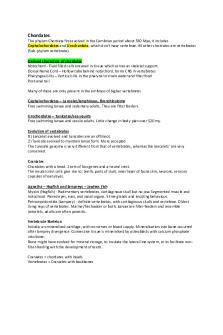Profile Diagram - Lecture notes 12 PDF

| Title | Profile Diagram - Lecture notes 12 |
|---|---|
| Author | aiswarya sanoj |
| Course | Agile Software Development |
| Institution | Amity University |
| Pages | 5 |
| File Size | 213.8 KB |
| File Type | |
| Total Downloads | 53 |
| Total Views | 129 |
Summary
very informative note...
Description
Profile Diagram Profile diagram is basically an extensibility mechanism that allows you to extend and customize UML by adding new building blocks, creating new properties and specifying new semantics in order to make the language suitable to your specific problem domain. Profile diagram has three types of extensibility mechanisms:
● Stereotypes ● Tagged Values
Stereotypes Stereotypes allow you to increase vocabulary of UML. You can add, create new model elements, derived from existing ones but that have specific properties that are suitable to your problem domain. Stereotypes are used to introduce new building blocks that speak the language of your domain and look primitive. It allows you to introduce new graphical symbols. For example: When modeling a network you might need to have symbols for , , etc. A stereotype allows you to make these things appear as primitive.
Tagged Values Tagged values are used to extend the properties of UML so that you can add additional information in the specification of a model element. It allows you to specify keyword value pairs of a model where keywords are the attributes. Tagged values are graphically rendered as string enclose in brackets. For Example: Consider a release team responsible for assembling, testing and deployment of a system. In such case it is necessary to keep a track on version and test results of the main subsystem. Tagged values are used to add such info. Tagged Value can be useful for adding properties to the model for some useful purposes:
● Code generation ● Version control ● Configuration management ● Authorship ● Etc
Constraints
They are the properties for specifying semantics or conditions that must be held true at all the time. It allows you to extend the semantics of UML building block by adding new protocols. Graphically a constraint is rendered as string enclose in brackets placed near associated element. For example: In development of a real time system it is necessary to adorn the model with some necessary information such as response time. A constraint defines a relationship between model elements that must be use {subset} or {xor}. Constraints can be on attributes, derived attributes and associations. It can be attached to one or more model elements shown as a note as well.
UML Profile can be defined in one of the following 3 ways:
● Creation of a new metamodel ● Extension and modification of the UML metamodel ● Extension of the UML metamodel with language-inherent mechanisms
Other Popular Usages for UML profiles Every technical target, i.e. programming language, middleware, library or database is a natural candidate for defining UML profile. For examples:
● CORBA ● EJB ● C++ or JAVA ● ORACLE or MYSQL ● Etc
Profile Diagram Example I - IT Management A profile is applied to another package in order to make the stereotypes in the profile available to that package. The illustration below shows the Network, Telecomms and Software profiles being applied to the ITManagement package....
Similar Free PDFs

12 - Lecture notes 12
- 3 Pages

Lecture notes, lecture 12
- 9 Pages

Lecture notes, lecture 12
- 7 Pages

Chapter 12 - Lecture notes 12
- 4 Pages

Lab 12 - Lecture notes 12
- 5 Pages

LEC 12 - Lecture notes 12
- 3 Pages

(12) Mistake - Lecture notes 12
- 8 Pages

Chapter 12 - Lecture notes 12
- 9 Pages

Lecture notes, lecture 1-12
- 64 Pages

Sachvui - Lecture notes 12
- 271 Pages

Mujadid - Lecture notes 12
- 1 Pages

Lecture 11 + 12 notes
- 16 Pages
Popular Institutions
- Tinajero National High School - Annex
- Politeknik Caltex Riau
- Yokohama City University
- SGT University
- University of Al-Qadisiyah
- Divine Word College of Vigan
- Techniek College Rotterdam
- Universidade de Santiago
- Universiti Teknologi MARA Cawangan Johor Kampus Pasir Gudang
- Poltekkes Kemenkes Yogyakarta
- Baguio City National High School
- Colegio san marcos
- preparatoria uno
- Centro de Bachillerato Tecnológico Industrial y de Servicios No. 107
- Dalian Maritime University
- Quang Trung Secondary School
- Colegio Tecnológico en Informática
- Corporación Regional de Educación Superior
- Grupo CEDVA
- Dar Al Uloom University
- Centro de Estudios Preuniversitarios de la Universidad Nacional de Ingeniería
- 上智大学
- Aakash International School, Nuna Majara
- San Felipe Neri Catholic School
- Kang Chiao International School - New Taipei City
- Misamis Occidental National High School
- Institución Educativa Escuela Normal Juan Ladrilleros
- Kolehiyo ng Pantukan
- Batanes State College
- Instituto Continental
- Sekolah Menengah Kejuruan Kesehatan Kaltara (Tarakan)
- Colegio de La Inmaculada Concepcion - Cebu



